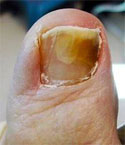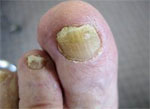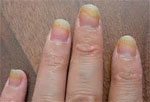At the first sign of toenail fungus, sufferers are already in pain. Tenderness in the toenail or an unpleasant odor are symptoms of this nail-infecting nuisance. If left untreated, toenail fungus can quickly become a serious problem leading to permanent nail damage, spreading the fungi to other nails or an additional infection. A white or yellow spot found on the tip of the nail may indicate the presence of toenail fungus, as can a discoloration or thickening of the nail. The discoloration comes from bacteria that is forming underneath the nail and is very difficult to overlook. Many sufferers will attempt to conceal the infection with nail polish, but this is not advisable as these products can often trap the bacteria and cause it to worsen. Toenail fungus can often be diagnosed as brittle or crumbling nails.
Of all known nail disorders, nail fungus is responsible for half. Because it can often be difficult to treat, the best way to effectively fight toenail fungus is to detect is early and begin a treatment regimen that works to eliminate the bacteria causing the infection. Nails that are distorted in shape or seem to be dull and lusterless are also common signs of toenail fungus.
A qualified medical doctor will be able to properly diagnose toenail fungus by first examining the area and scraping a portion of the debris under the nails for further studies. Once taken, the sample will be examined by the physician or a laboratory technician, under a microscope or similar equipment in order to make a final determination. If the results show toenail fungus is present, the physician will typically prescribe an anti-fungal cream or other medication for immediate treatment.
The best way to avoid having to watch for signs of toenail fungus is to take preventative steps in order to make sure you are not allowing yourself to be in an environment that may increase the chances of contracting the bacteria. One such way is to keep both the fingernails and toenails clean and short. This will eliminate extra room for bacteria to form and worsen. In addition, keeping the nails dry after hand-washing, showers and swimming will also help to prevent toenail fungus. It’s also important to remember that when visiting a nail salon, the customer must make sure that the salon is properly disinfecting their equipment. Because these same utensils are used to treat the nails of various individuals, it is possible to spread bacteria if the salon products are not properly cleaned.




